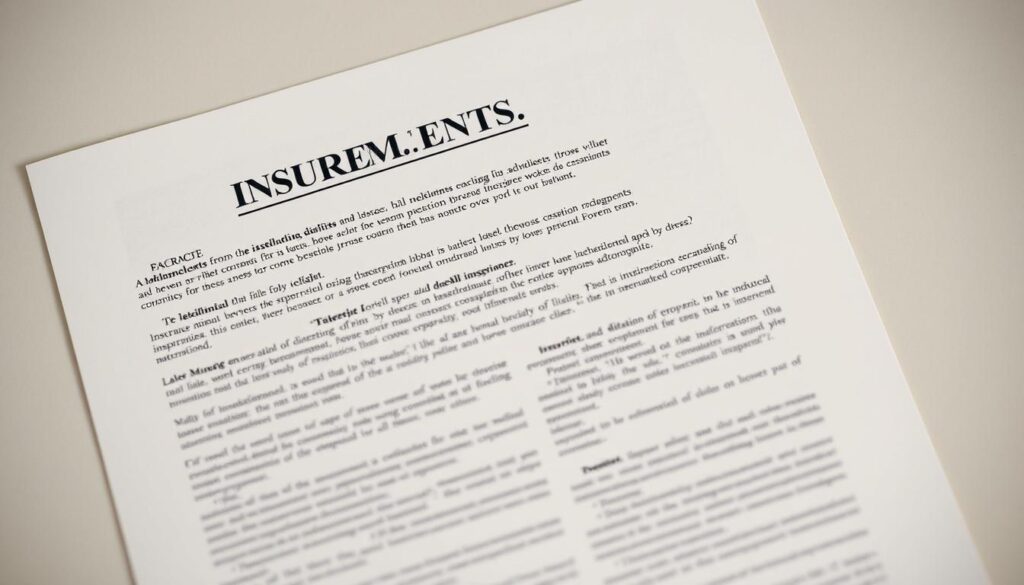The landscape of insurance coverage is evolving rapidly, leaving many individuals and businesses vulnerable to unforeseen risks.
As the world becomes increasingly complex, the limitations of basic insurance policies are becoming more apparent, exposing insurance coverage gaps that can have significant financial implications.
Understanding what is not covered by your basic policy is crucial in today’s uncertain environment. Conducting an insurance gap analysis can help identify areas where you are underinsured, enabling you to make informed decisions about additional coverage.
This article will explore the modern insurance gaps and provide insights into how to address them effectively.
The Evolving Landscape of Insurance Coverage
The insurance landscape is undergoing a significant transformation due to technological advancements. This shift is driven by the need to address modern risks that traditional insurance models are not equipped to handle.
Historical Coverage vs. Today’s Realities
Historically, insurance policies were designed to cover specific, well-defined risks. However, today’s realities demand more nuanced and flexible coverage due to the rapid pace of technological change and shifting societal needs.
| Traditional Insurance Models | Modern Insurance Models |
|---|---|
| Static, one-size-fits-all coverage | Dynamic, customizable coverage |
| Limited flexibility | Flexible, on-demand coverage |
Economic and Social Factors Driving Policy Changes
Economic and social factors, such as the gig economy and increased cyber threats, are driving changes in insurance policies. Insurers are now leveraging technology to provide more tailored coverage that addresses these emerging risks.

Understanding Modern Insurance Gaps
The modern insurance landscape is fraught with gaps that can leave policyholders exposed to significant financial risks. As the nature of risks evolves, standard insurance policies often fail to provide adequate coverage, leading to insurance coverage gaps.
Definition and Impact on Policyholders
Modern insurance gaps refer to the discrepancies between the coverage provided by standard insurance policies and the actual risks faced by policyholders. These gaps can have a substantial impact on individuals and businesses, potentially leading to financial hardship in the event of unforeseen circumstances. Regular insurance policy audits are essential to identify and address these gaps.
Common Misconceptions About Standard Coverage
Many policyholders assume that their standard insurance policies cover all potential risks. However, this is often not the case. Hidden exclusions in policy language can leave policyholders vulnerable.
Hidden Exclusions in Policy Language
Policy language can be complex, with exclusions that are not immediately apparent. Understanding these exclusions is crucial for closing insurance loopholes and ensuring comprehensive coverage. For instance, some policies may not cover cyber-related losses, highlighting the need for cyber insurance protection.

Technology-Related Exposures
With the increasing reliance on technology, individuals and businesses face new risks that are not typically covered by basic insurance policies. The growing need for cyber insurance protection is a prime example, as technology advancements in insurance have not kept pace with the rapid digital transformation in insurance needs.
Cyber Liability and Identity Theft
Cyber liability and identity theft are significant concerns. As more personal and financial information is stored online, the risk of cyber-attacks and data breaches increases. Specialized insurance coverage can help mitigate these risks.
Smart Home Device Failures and Malfunctions
Smart home devices, while convenient, can fail or malfunction, causing inconvenience and potential financial loss. Insurance policies that cover these devices can provide necessary protection.
Digital Asset Protection
Digital assets, including data and intellectual property, require protection. Insurance coverage for these assets can help businesses recover from losses due to cyber-attacks or data breaches.
Emerging Lifestyle and Work Risks
Emerging trends in work and lifestyle are giving rise to new exposures that require innovative insurance solutions. The modern workforce is characterized by a shift towards non-traditional arrangements, including gig economy work, home-based businesses, and short-term rentals.
This shift has introduced a myriad of risks that traditional insurance policies often fail to address, highlighting the need for addressing modern risks through tailored insurance products.
Gig Economy and Freelance Work Exposures
Gig economy workers face unique risks, including liability for accidents or injuries that occur while working. Traditional insurance policies often don’t cover these risks, leaving workers exposed. For instance, a freelancer may not be covered for equipment damage or business interruption.
Home-Based Business Operations
Running a business from home can introduce new risks, such as business interruption, cyber threats, and equipment failure. Standard homeowners’ insurance typically doesn’t cover these risks, necessitating specialized coverage.
Rideshare and Short-Term Rental Gaps
Drivers for rideshare companies and hosts on short-term rental platforms face specific risks, including liability for accidents or property damage. Specialized insurance products are needed to address these gaps.
| Risk Category | Common Exposures | Insurance Gaps |
|---|---|---|
| Gig Economy | Liability, Accidents | Traditional policies |
| Home-Based Business | Business Interruption, Cyber Threats | Standard homeowners’ insurance |
| Rideshare/Short-Term Rental | Liability, Property Damage | Standard auto/home insurance |
Environmental and Climate Change Exclusions
The increasing frequency and severity of environmental disasters have exposed significant gaps in traditional insurance coverage. As climate change continues to manifest in various forms, insurance policies have started to reflect the changing risk landscape, often through exclusions and limitations.
Understanding these exclusions is crucial for policyholders to assess their risk exposure accurately. Insurance companies are now more likely to exclude or limit coverage for certain climate-related events, making it essential for individuals to review their policies carefully.
Flood Insurance Limitations and Requirements
Flood insurance is a critical component of risk management for many, especially those living in flood-prone areas. However, standard policies often come with limitations and specific requirements that policyholders must meet to qualify for coverage.
For instance, the National Flood Insurance Program (NFIP) in the United States provides coverage up to certain limits, and policyholders may need to purchase additional coverage if these limits are exceeded. Moreover, properties in high-risk flood zones may face stricter requirements or higher premiums.
Wildfire Coverage Restrictions in High-Risk Areas
Wildfires have become increasingly common in various parts of the world, leading to significant losses for homeowners and businesses. Insurance policies in high-risk areas often contain restrictions or exclusions related to wildfire damage.
Policyholders in these areas need to be aware of these restrictions and consider additional coverage options or mitigation measures to reduce their risk.
Extreme Weather Event Exclusions
Extreme weather events, including hurricanes, tornadoes, and storms, are becoming more frequent and intense due to climate change. Insurance policies often exclude or limit coverage for certain types of damage caused by these events.
Hurricane and Earthquake Coverage Considerations
Hurricanes and earthquakes are among the most destructive natural disasters, and insurance coverage for these events can be complex. Policyholders may need to purchase separate policies or endorsements to ensure they are adequately covered.
For example, hurricane insurance may cover wind damage but exclude flooding, which requires a separate flood insurance policy. Similarly, earthquake insurance is often not included in standard homeowners’ policies and must be purchased separately or added as an endorsement.
| Climate-Related Risk | Typical Insurance Exclusions/Limitations | Additional Coverage Options |
|---|---|---|
| Floods | Standard homeowners’ policies often exclude flood damage. NFIP coverage limits apply. | Excess flood insurance, private flood insurance |
| Wildfires | Policies in high-risk areas may restrict or exclude wildfire damage. | Specialized wildfire insurance, mitigation measures |
| Hurricanes | Wind damage may be covered, but flooding is often excluded. | Flood insurance, hurricane endorsements |
| Earthquakes | Typically not covered under standard homeowners’ policies. | Separate earthquake insurance policies or endorsements |
In conclusion, understanding the exclusions and limitations in insurance policies related to environmental and climate change risks is vital for effective risk management. Policyholders must be proactive in reviewing their coverage and exploring additional options to ensure they are adequately protected against the evolving climate-related risks.
Health Insurance Coverage Limitations
The healthcare industry’s rapid evolution is exposing significant gaps in traditional health insurance coverage. As medical technology advances and patient needs change, it’s becoming clear that current insurance models are not fully addressing modern risks.
Telehealth Services and Digital Healthcare
The rise of telehealth has transformed the way healthcare is delivered. However, innovative insurance solutions are needed to fully cover these services. Many insurance plans still have limitations on telehealth coverage, leaving patients with unexpected expenses.
Mental Health Treatment Coverage Gaps
Mental health treatment is an essential aspect of overall healthcare. Yet, many insurance plans have coverage gaps, including limited sessions for therapy or restrictive provider networks. Addressing these gaps is crucial for comprehensive care.
Long-Term Care and Chronic Condition Management
Long-term care and chronic condition management require sustained support, often not fully covered by traditional health insurance. Technology advancements in insurance can help create more comprehensive coverage models that address these needs.
| Coverage Area | Traditional Insurance | Innovative Solutions |
|---|---|---|
| Telehealth Services | Limited Coverage | Comprehensive Coverage |
| Mental Health Treatment | Gaps in Coverage | Enhanced Benefits |
| Long-Term Care | Restricted Coverage | Flexible Options |
Conducting Your Personal Insurance Gap Analysis
A personal insurance gap analysis is a vital tool for ensuring you’re adequately protected against unforeseen risks. This process involves a thorough review of your current insurance policies to identify potential gaps in coverage.
Reviewing Your Current Policies Step-by-Step
Begin by gathering all your insurance policies and reviewing them step-by-step. Check for coverage limits, deductibles, and any exclusions. It’s essential to understand what is covered and what is not.
Identifying Personal and Family Risk Exposures
Next, identify potential risks that could impact you and your family. Consider factors such as your health, financial situation, and lifestyle. This will help you understand where you might be vulnerable.
Working with Insurance Professionals
Insurance professionals can provide valuable insights and guidance. They can help you understand complex policy terms and recommend appropriate coverage.
Questions to Ask Your Insurance Agent
- What are the coverage limits and deductibles for my policies?
- Are there any exclusions or limitations I should be aware of?
- How can I tailor my policies to fit my specific needs?
Regularly reviewing and updating your insurance coverage is crucial. As your circumstances change, so too should your insurance policies.
| Insurance Type | Coverage Limits | Deductibles |
|---|---|---|
| Health Insurance | $100,000 | $1,000 |
| Home Insurance | $300,000 | $500 |
| Auto Insurance | $100,000 | $500 |
Protecting Your Future: Strategies for Comprehensive Coverage
As the insurance landscape continues to evolve, it’s essential to stay informed about modern insurance gaps that can leave you vulnerable to emerging risks. By understanding the limitations of your current policies, you can take proactive steps to address these gaps and ensure comprehensive coverage.
Innovative insurance solutions are being developed to address modern risks, including cyber liability, smart home device failures, and environmental disasters. By working with insurance professionals and staying up-to-date on the latest coverage options, you can protect your future and safeguard your financial well-being.
Addressing modern risks requires a proactive approach to insurance management. By regularly reviewing your policies and identifying potential gaps, you can ensure that you have the coverage you need to mitigate potential losses and protect your assets.

